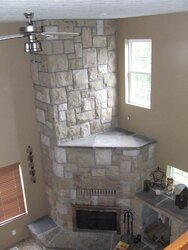I'm finding I have to revise the way I think about chimneys. I've always believed masonry chimneys are inherently superior to insulated metal pipe chimneys, but every boiler vendor I've asked has said there is no advantage to a masonry chimney over insulated pipe. In fact, one vendor told me I would have to line the masonry chimney with stainless steel.
Since I already have insulated galvanized steel pipes available (old, but they're there), is there any reason I should be considering replacing them with a block chimney?
Ken Benson
Since I already have insulated galvanized steel pipes available (old, but they're there), is there any reason I should be considering replacing them with a block chimney?
Ken Benson



 is some nice work. I bet it makes a dandy radiator after it's had a fire in it for a day also. Very nice Piker. Very nice. True craftsmanship is easy to spot.
is some nice work. I bet it makes a dandy radiator after it's had a fire in it for a day also. Very nice Piker. Very nice. True craftsmanship is easy to spot.